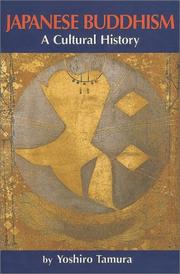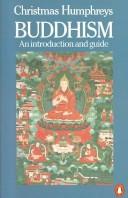| Listing 1 - 10 of 10 |
Sort by
|
Book
ISBN: 9781905246595 9781905246410 1905246595 Year: 2007 Publisher: Folkestone Global oriental
Abstract | Keywords | Export | Availability | Bookmark
 Loading...
Loading...Choose an application
- Reference Manager
- EndNote
- RefWorks (Direct export to RefWorks)
J1800 --- Japan: Religion -- Buddhism -- general and history --- Monasticism and religious orders, Buddhist --- Buddhism --- History.
Book
ISBN: 9784003332313 4003332318 Year: 2006 Publisher: 東京 岩波書店
Abstract | Keywords | Export | Availability | Bookmark
 Loading...
Loading...Choose an application
- Reference Manager
- EndNote
- RefWorks (Direct export to RefWorks)
Pure Land Buddhism --- Buddhism --- History. --- History --- J1800 --- Japan: Religion -- Buddhism -- general and history

ISBN: 4333016843 9784333016846 Year: 2000 Publisher: Tokyo Kosei
Abstract | Keywords | Export | Availability | Bookmark
 Loading...
Loading...Choose an application
- Reference Manager
- EndNote
- RefWorks (Direct export to RefWorks)
Buddhism --- J1800 --- History --- Japan: Religion -- Buddhism -- general and history --- Bouddhisme --- Buddhism. --- Histoire --- Japan.
Book
ISBN: 080481192X 9780804811927 Year: 1984 Publisher: Rutland Tuttle
Abstract | Keywords | Export | Availability | Bookmark
 Loading...
Loading...Choose an application
- Reference Manager
- EndNote
- RefWorks (Direct export to RefWorks)
J1800 --- Japan: Religion -- Buddhism -- general and history --- Buddhism --- Buddha and Buddhism --- Lamaism --- Ris-med (Lamaism) --- Religions --- Jōdoshū. --- 净土宗 --- 浄土宗 --- 淨土宗 --- Bouddhisme --- Boeddhisme.
Book
ISBN: 3317015969 Year: 1986 Publisher: Bern Francke
Abstract | Keywords | Export | Availability | Bookmark
 Loading...
Loading...Choose an application
- Reference Manager
- EndNote
- RefWorks (Direct export to RefWorks)

ISBN: 0140202285 9780140202281 Year: 1978 Publisher: Harmondsworth Penguin Books
Abstract | Keywords | Export | Availability | Bookmark
 Loading...
Loading...Choose an application
- Reference Manager
- EndNote
- RefWorks (Direct export to RefWorks)
Book
ISBN: 9782600012287 9782600011914 9782600011921 2600012281 2600011919 2600011927 Year: 2008 Volume: 45 9 Publisher: Genève : Droz,
Abstract | Keywords | Export | Availability | Bookmark
 Loading...
Loading...Choose an application
- Reference Manager
- EndNote
- RefWorks (Direct export to RefWorks)
Buddhism --- Japanese language --- Bouddhisme --- Japonais (Langue) --- Dictionaries --- French --- Terminology --- Dictionnaires français --- Terminologie --- Japan --- Japon --- Religion --- Buddhism -- Japan -- Dictionaries. --- Dictionnaires français --- French. --- J1800 --- J1806 --- Buddha and Buddhism --- Lamaism --- Ris-med (Lamaism) --- Religions --- Japan: Religion -- Buddhism -- general and history --- Japan: Religion -- Buddhism -- reference works --- Japanese buddhism --- Vocabulary --- Terminology.
Book
ISBN: 9780415550000 9780415550017 0415550009 0415550017 Year: 2010 Publisher: London Routledge
Abstract | Keywords | Export | Availability | Bookmark
 Loading...
Loading...Choose an application
- Reference Manager
- EndNote
- RefWorks (Direct export to RefWorks)
Introducing Buddhism is the ideal resource for all students beginning the study of this fascinating religious tradition. It explains the religion's key teachings and traces its historical development and geographical spread of from its foundations up to present day. Charles S. Prebish and Damien Keown, two of today's leading Buddhist scholars, devote a chapter each to the major regions where Buddhism has flourished - India, South-east Asia, East Asia and Tibet. In addition, contemporary concerns are discussed, including important and relevant topics such as Engaged Buddhism, Buddhist Ethics, Buddhism and the Western World and Meditation.
Buddhism --- J1800 --- K9070 --- S13A/0310 --- S24/0910 --- S37/0200 --- Buddha and Buddhism --- Lamaism --- Ris-med (Lamaism) --- Religions --- Japan: Religion -- Buddhism -- general and history --- Korea: Religion -- Buddhism -- general and history --- China: Religion--Buddhism: China --- Tibet--Tibetan Buddhism: general --- Buddhism outside China, Tibet, Mongolia and Japan--General works
Book
ISBN: 9789004184916 9004184910 9789004204010 9004204016 1283119579 9786613119575 9781283119573 6613119571 Year: 2011 Volume: 24 Publisher: Leiden Boston Brill
Abstract | Keywords | Export | Availability | Bookmark
 Loading...
Loading...Choose an application
- Reference Manager
- EndNote
- RefWorks (Direct export to RefWorks)
In all likelihood, it was the form of Buddhism labeled “Esoteric Buddhism” that had the greatest geographical spread of any form of Buddhism. It left its imprint not only on its native India, but far beyond, on Southeast Asia, Central Asia, including Tibet and Mongolia, as well as the East Asian countries China, Korea and Japan. Not only has Esoteric Buddhism contributed substantially to the development of Buddhism in many cultures, but it also facilitated the transmission of religious art and material culture, science and technology. This volume, the result of an international collaboration of forty scholars, provides a comprehensive resource on Esoteric Buddhism and the Tantras in their Chinese, Korean, and Japanese contexts from the first few centuries of the common era right up to the present. Contributors include: Barbara Ambrose, Anna Andreeva, Sarah Aptilon, Ian Astley, Clemente Beghi, Heather Blair, William Bodiford, Chen Jinhua, Paul Copp, Ronald M. Davidson, Lucia Dolce, Athanasios Drakakis, Donald Drummond, Ruth Dunnell, Jay Ford, David Gardiner, Rolf Giebel, Robert M. Gimello, David Gray, Elizabeth ten Grotenhuis, Nobumi Iyanaga, George Keyworth, Martin Lehnert, Hun Y. Lye, Shinya Mano, Richard M. McBride, Laura Meeks, Regan Murphy, Charles D. Orzech, Richard K. Payne, Klaus Pinte, Fabio Rambelli, Thierry Robouam, James Robson, Brian Ruppert, Neil Schmid, Gaynor Sekimori, Shen Weirong, Henrik H. Sørensen, Mark Unno, Pamela Winfield
Tantric Buddhism --- Bouddhisme tantrique --- Tantras --- Tantras. --- S13A/0315 --- S13A/0310 --- J1876 --- J1873 --- J1800 --- K9076 --- K9070 --- China: Religion--Chinese Buddhism: sects: general --- China: Religion--Buddhism: China --- Japan: Religion -- Buddhism -- Shingon --- Japan: Religion -- Buddhism -- Tendai --- Japan: Religion -- Buddhism -- general and history --- Korea: Religion -- Buddhism -- schools, sects and denominations --- Korea: Religion -- Buddhism -- general and history --- Buddhism, Tantric --- Buddhist tantrism --- Esoteric Buddhism --- Mantrayāna Buddhism --- Mikkyō --- Tantrism, Buddhist --- Vajrayāna Buddhism --- Buddhism --- Mahayana Buddhism --- Mandalas --- Āgamas
Book
ISBN: 022628641X 9780226286419 9780226286389 022628638X Year: 2016 Publisher: Chicago London
Abstract | Keywords | Export | Availability | Bookmark
 Loading...
Loading...Choose an application
- Reference Manager
- EndNote
- RefWorks (Direct export to RefWorks)
Since its arrival in Japan in the sixth century, Buddhism has played a central role in Japanese culture. But the historical figure of the Buddha, the prince of ancient Indian descent who abandoned his wealth and power to become an awakened being, has repeatedly disappeared and reappeared, emerging each time in a different form and to different ends. A Storied Sage traces this transformation of concepts of the Buddha, from Japan's ancient period in the eighth century to the end of the Meiji period in the early twentieth century. Micah L. Auerback follows the changing fortune of the Buddha through the novel uses for the Buddha's story in high and low culture alike, often outside of the confines of the Buddhist establishment. Auerback argues for the Buddha's continuing relevance during Japan's early modern period and links the later Buddhist tradition in Japan to its roots on the Asian continent. Additionally, he examines the afterlife of the Buddha in hagiographic literature, demonstrating that the late Japanese Buddha, far from fading into a ghost of his former self, instead underwent an important reincarnation. Challenging many established assumptions about Buddhism and its evolution in Japan, A Storied Sage is a vital contribution to the larger discussion of religion and secularization in modernity.
Buddhism --- J1800 --- J1830 --- Japan: Religion -- Buddhism -- general and history --- Japan: Religion -- Buddhism -- deities --- Gautama Buddha. --- Gautama, --- Fo-tʻo --- Buddha, --- Gotama, --- Shih-chia-mou-ni --- Shijiamuni --- Sākyamuni --- Sŏkka --- Buddha --- Sŏgamoni --- Shākyamuni --- Shakamuni-butsu --- Shakuson --- Shittaruta --- Shih-chia Ju-lai --- Phraphutthačhao --- Pultʻa --- Putta --- Siddhartha Gotama --- Gotama, Siddhartha --- Budda --- Śākya-thup-pa --- Shi-chia-mu-ni --- Siddhartha Gautama --- Gautama, Siddhartha --- Bhayavat --- Tathagata --- Siduhat Kumāraya --- Puttar --- Puttan̲ --- Kautama Puttar --- Puttapirān̲ --- Cittārtta Kautama Puttar --- Siddhārtha, --- Tất Đạt Đa --- בודהא --- 釈迦 --- 释迦牟尼 --- 釋迦牟尼 --- E-books --- Sitthattha Khōtama --- Khōtama, Sitthattha --- Gotama, Siddhatta --- Buddhism. --- Chōsen Kōgei Kenkyūkai. --- Japan. --- Buddha. --- Sakyamuni. --- canonicity. --- hagiography. --- historicism. --- secularization. --- vernacularization.
| Listing 1 - 10 of 10 |
Sort by
|

 Search
Search Feedback
Feedback About UniCat
About UniCat  Help
Help News
News